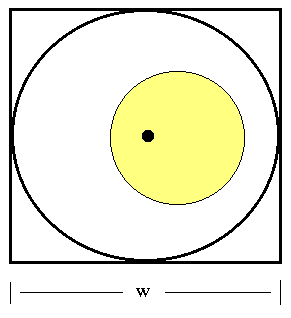- (1-dimensional ODE)
What is the gravitational potential everywhere inside, and
just outside of a spherically symmetric mass distribution of radius
R and arbitrary density distribution r(r)?
Required Analytical Test: A uniform-density sphere.
Constraints: Use a spherical coordinate grid whose outer boundary is located a distance 2R from the center of the spherical mass. Solve the system of linear algebraic equations directly, using a Gaussian elimination technique.
- (2-dimensional, elliptic PDE)
What is the gravitational potential everywhere
inside, and just outside of a cylindrically symmetric mass distribution of radius
R and arbitrary density distribution r(r)?
Required Analytical Test: A uniform-density cylinder whose axis of symmetry is shifted off of the center of the computational grid.
Constraints: Use a Cartesian grid whose width is twice the diameter of the cylinder (w = 4R) and shift the cylinder so that its symmetry axis is a distance R/2 from the center of the grid. Solve the system of linear algebraic equations using an ADI (alternating direction, implicit) or multi-grid technique.
- (1-dimensional hyperbolic PDE)
Write a finite-difference algorithm that will evolve forward
in time an inviscid, one-dimensional (Cartesian), compressible
fluid flow.
Use an explicit, "upwind" integration scheme that is accurate to
first order in space and time.
Required Analytical Test: The Sod Shock Tube problem (Sod 1978).
Constraints: Start with the same initial conditions used by Sod (1978) and follow the flow up to a time t = 0.245; use a uniformly spaced grid that extends from x = 0 to 1, and position the initial contact-discontinuity at x = 0.5; and track the behavior of four principal variables: the fluid pressure P, mass density r, velocity vx, and entropy tracer t/r. [Note that the equation governing evolution of the entropy tracer can be derived from the adiabatic form of the first Law of Thermodynamics, as shown on the accompanying page.]Optional: Show a "movie" of your results compared with the analytical result from time t = 0 through 0.245.
- (2-dimensional, hyperbolic PDE)
Perform the same simulation, but on a two-dimensional
(2D) Cartesian grid with the contact-discontinuity (membrane) initially
inclined at 30 degrees to the x-axis. At time t = 0.245, examine
properties of the flow along several different lines that are
perpendicular to the membrane; for example, extending from
the midpoint of the membrane and at positions +/- 0.25 away from
that point.
Constraints: At all grid boundaries, employ a "free-flow" boundary condition such that material is permitted to flow freely off of the grid, but no material is permitted to re-enter the grid.
- Using a 2D FFT technique, calculate the digital holographic
image of a 2D rectangular aperture (arbitrary size and aspect
ratio), and compare the result to the analytically known result.
Deduce how the "amplitude, width, and extent" of your numerically generated
function compares with the corresponding amplitude and width of
the relevant "sinc*sinc" function.
- Our ultimate objective is to design and build a computational
algorithm that will generate -- in the most computationally
efficient manner possible -- a digital hologram that
contains the three visible faces of a rectangular solid having dimensions
15 cm x 10 cm x 5 cm, as
viewed from a distance of 5 m, but from an arbitrary viewing angle.
The hologram should have a resolution of at least 500 x 500 pixels.